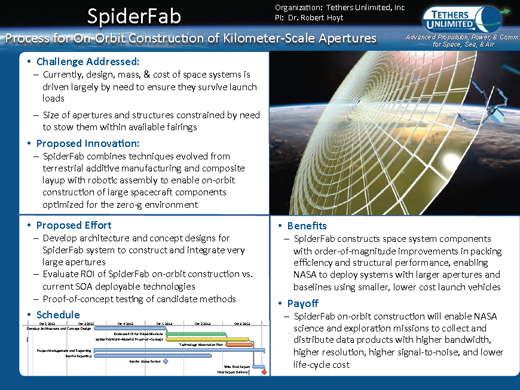NASA Investigating 3D Printing to Build Satellites in Space

Potential for 3D printing satellites in space. Courtesy of NASA.
Latest News
September 21, 2012
If any governmental agency counts as an early adopter of additive manufacturing (AM), it would be NASA. Parts of the Space Exploration Vehicle (SEV) being constructed for use with a manned mission to Mars are being built using AM, and the agency is talking about putting a compact 3D printer on board the SEV.
It seems like NASA is seriously considering making 3D printers part of the standard equipment for every space mission, owing to the flexibility of the technology. Never afraid to push the envelope, the space agency is looking into other ways AM can be used to improve space exploration and reduce costs at the same time.
It costs a lot to get a satellite in orbit, and the larger the satellite, the greater the expense. This is one reason for the rise of CubeSats, which are tiny satellites packed with technology. Multiple CubeSats can be put in orbit for the same cost as one larger satellite. CubeSats aren’t the answer to every problem, however. Some satellites must be built on a larger scale to satisfy the purpose for their existence.
Tethers Unlimited (TU) has proposed a partial solution to the expense of launching large satellites into orbit. Most satellites are designed to kind of fold up to fit inside whatever vehicle is being used to propel it into space. In place of designing a satellite to survive launch, NASA and TU are investigating the use of AM to build large sections of satellites while in orbit.
The proposed solution is a 3D printer called SpiderFab. According to NASA’s website, the AM solution would use:
… a novel additive manufacturing technique called ‘SpiderFab,’ which combines the techniques of fused deposition modeling (FDM) with methods derived from automated composite layup to enable rapid construction of very large, very high-strength-per-mass, lattice-like structures combining both compressive and tensile elements. This technique can integrate both high-strength structural materials and conducting materials to enable construction of multifunctional space system components such as antennas.
This approach would allow NASA to ship raw materials, and any components that can’t be fabricated, into space without having to design the shipment for a launch environment. The SpiderFab would consume the materials and continue to build whatever type of structure was required.
This is a novel solution to a problem that highlights the many different ways that AM can be used. If the SpiderFab system works, it’ll not only save NASA money, but it might even speed up development of future satellites, offering a number of different potential applications.
Below you’ll find a short video that discusses CubeSats.
Source: NASA
Subscribe to our FREE magazine, FREE email newsletters or both!
Latest News
About the Author
John NewmanJohn Newman is a Digital Engineering contributor who focuses on 3D printing. Contact him via [email protected] and read his posts on Rapid Ready Technology.
Follow DE






